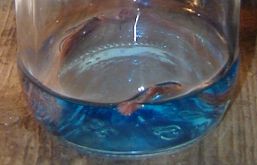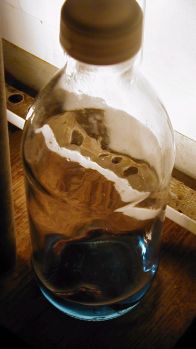










 ) that
he didn't know the amount of crystallization water (which is 5) so he decided to dehydrate it to measure the exact required amount
) that
he didn't know the amount of crystallization water (which is 5) so he decided to dehydrate it to measure the exact required amount ) and "anodized" some copper wire with it (using a graphite cathode).
) and "anodized" some copper wire with it (using a graphite cathode).


 I'm currently plating that solution out, with an aluminum anode, of all things...)
I'm currently plating that solution out, with an aluminum anode, of all things...) ), and react this with 30% HCl, and distill the acetic acid azeotrope. It's all
possible if one tries hard enough!
), and react this with 30% HCl, and distill the acetic acid azeotrope. It's all
possible if one tries hard enough! 
 ), I decanted it once again and attempted to wash the white stuff - now I've got a solution that's turning
orange again! DOH! But that would suggest that CuCl is only stable at lower pH; wouldn't a lower pH oxidize it further to CuCl2???
), I decanted it once again and attempted to wash the white stuff - now I've got a solution that's turning
orange again! DOH! But that would suggest that CuCl is only stable at lower pH; wouldn't a lower pH oxidize it further to CuCl2???
| Quote: |

 (copper tetrachloride ion, correct?) with no white precipitate,
further dissolution gives a light sky blue/cyan color (hydrated copper ion). Seems to be pretty pure divalent, at least.
(copper tetrachloride ion, correct?) with no white precipitate,
further dissolution gives a light sky blue/cyan color (hydrated copper ion). Seems to be pretty pure divalent, at least. ) I had a suspension of pale green basic copper carbonate (unless
there's some chloride in there; the solution was green chloride complex at the time). After some settling and washing, this was obtained. Maybe
100-200g?
) I had a suspension of pale green basic copper carbonate (unless
there's some chloride in there; the solution was green chloride complex at the time). After some settling and washing, this was obtained. Maybe
100-200g? but plumbers use it all the
time.
but plumbers use it all the
time.
| Quote: |
| Quote: |
| Quote: |
| Quote: |
| Quote: |
| Quote: |

 . I must have reduced nitrate to ammonia somehow. Seeing as this was running indoors, I turned off the power. Interesting. Perhaps if
the temp was kept lower, ammonia formation could be avoided.
. I must have reduced nitrate to ammonia somehow. Seeing as this was running indoors, I turned off the power. Interesting. Perhaps if
the temp was kept lower, ammonia formation could be avoided.| Quote: |
| Quote: |
| Quote: |